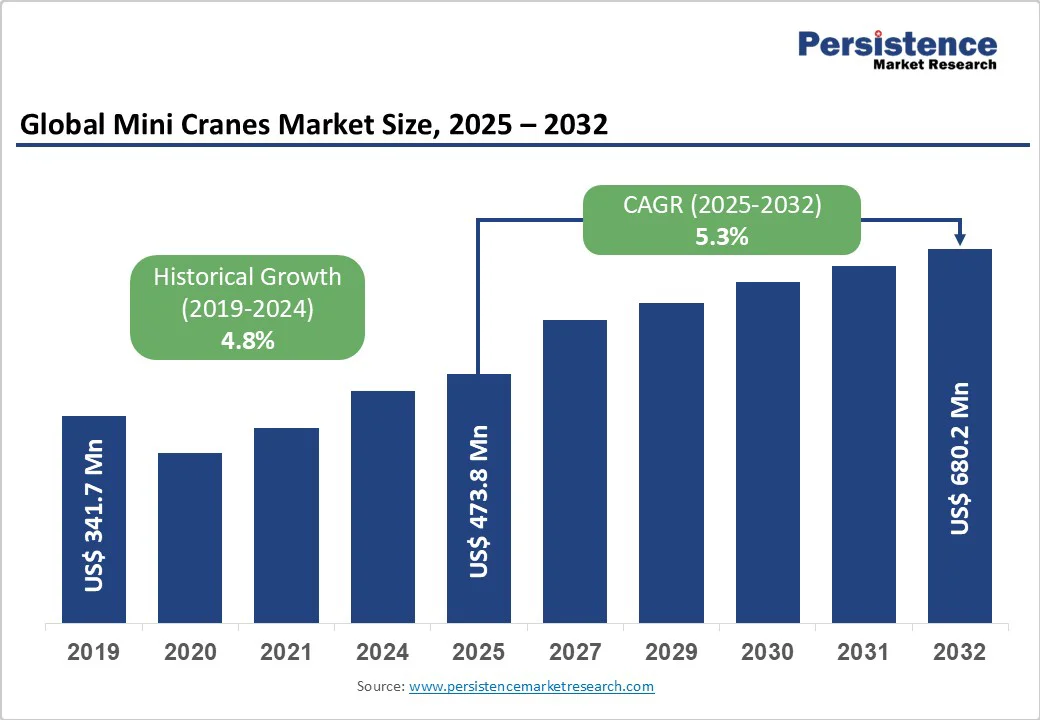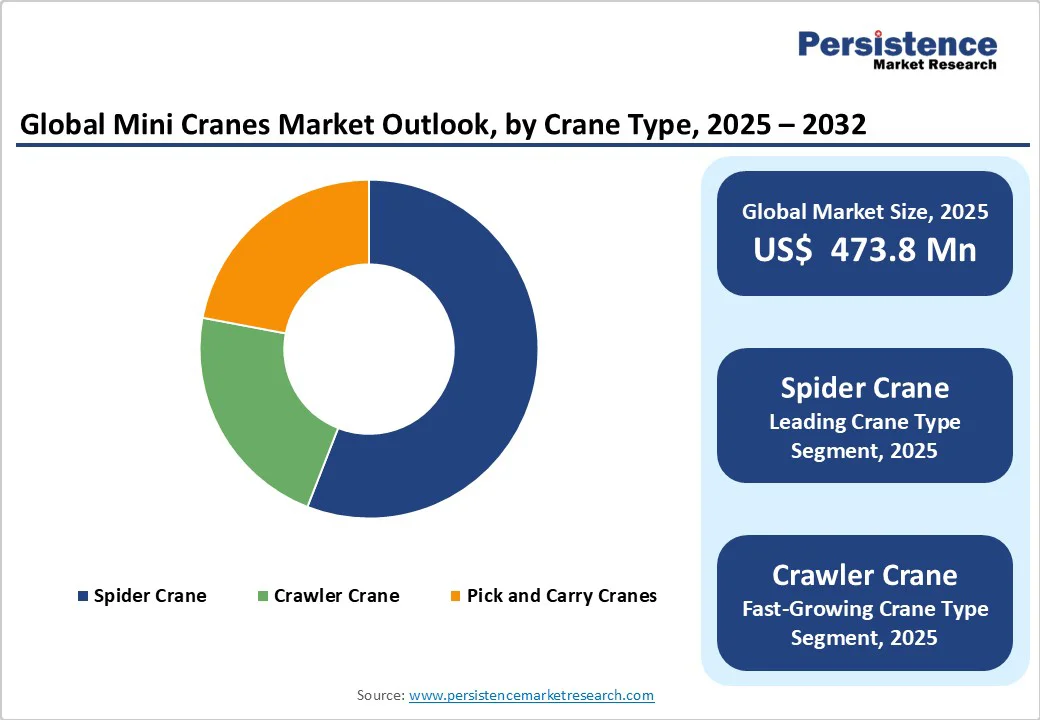ID: PMRREP35249| 196 Pages | 17 Oct 2025 | Format: PDF, Excel, PPT* | Industrial Automation

The global mini crane market size is likely to be valued at US$473.8 Million in 2025. It is expected to reach US$680.2 million by 2032, growing at a CAGR of 5.3% during the forecast period from 2025 to 2032, driven by the surging demand for compact lifting solutions across urban infrastructure, industrial maintenance, and construction projects.
| Key Insights | Details |
|---|---|
| Mini Crane Market Size (2025E) | US$473.8 Mn |
| Market Value Forecast (2032F) | US$680.2 Mn |
| Projected Growth (CAGR 2025 to 2032) | 5.3% |
| Historical Market Growth (CAGR 2019 to 2024) | 4.8% |

Urbanization and the rise of high-rise buildings have significantly increased the demand for compact lifting equipment, particularly mini cranes. These machines are designed to operate effectively in small spaces and indoors, making them ideal for use in residential renovations, commercial developments, and infrastructure maintenance projects. With miniature sizes and powerful lifts, mini cranes have become irreplaceable tools for modern urban construction.
Spider cranes are a type of mini crane, known for their versatility. They can pass through narrow passages, fit into elevators, and reach areas that are inaccessible on construction sites. These cranes are particularly useful in situations where large, traditional cranes cannot be used due to space constraints or complex site conditions.
As cities of the world move toward becoming smart cities, mini cranes are expected to grow in demand to support more innovative, efficient, and cost-effective construction solutions. The cranes not only contribute to increased productivity and safety but also reduce labor costs, hence being an important part of modern urban development tools.
A major restraint in the mini crane market is the complexity of maintenance and the lack of widespread service infrastructure, particularly in emerging or remote regions. Although mini cranes are designed to operate in compact and confined environments, they require regular maintenance to ensure safe and optimal performance, especially when used in challenging terrains such as construction sites, industrial plants, or rescue missions.
Mini cranes are now integrated with advanced technologies, including AI-powered load balancing systems, remote control mechanisms, and battery-electric drivetrains. While these features enhance operational capabilities, they also introduce complex maintenance requirements. Components such as hydraulic systems, battery packs, and electronic control units demand specialized servicing, which may not be readily available in all regions.
Maeda Seisakusho, a leader in spider cranes, has a strong presence in Japan and Europe. Still, its service network in developing countries remains limited, posing a barrier to adoption in Southeast Asia and Africa.
As industries worldwide increasingly shift toward sustainable and environmentally responsible operations, the demand for eco-friendly and electric mini cranes is gaining substantial momentum. The construction, manufacturing, and logistics sectors are under growing pressure to reduce their carbon footprints, comply with strict emissions regulations, and adopt green technologies, making electric mini cranes a vital solution.
Electric mini cranes offer zero-emission operation, making them ideal for indoor use, urban job sites, and environmentally sensitive areas such as hospitals, data centers, and historic preservation sites. Their quiet operation also supports noise-sensitive environments.
The increasing adoption of pick and carry cranes highlights a significant opportunity in the mini crane market. These mobile lifting machines are essential for worksites requiring efficient transport of loads over short distances. Their compact design and superior maneuverability make them ideal for industrial plants, warehouses, and urban construction projects, offering unmatched flexibility and efficiency in material handling within confined and congested areas.
The 2- to 5-ton lifting capacity segment dominates the global mini crane market, accounting for over 35% of the total demand in 2024. This segment strikes the perfect balance between compact design and robust lifting capability, making these cranes highly versatile and ideal for a wide range of applications, including construction, industrial maintenance, and logistics operations.
Mini cranes within this capacity range are particularly favored for medium-scale projects that demand precision lifting, enhanced maneuverability, and operational efficiency, especially in tight or restricted spaces where conventional cranes cannot perform effectively. Their ability to handle varied load requirements while maintaining high performance in compact environments has solidified their position as a go-to solution across multiple sectors.
The reliability, ease of transport, and multifunctionality of cranes in the 2 to 5-ton category continue to drive strong adoption rates. As industries increasingly seek cost-effective, space-saving lifting solutions, this segment remains at the forefront of the market’s expansion, supporting its continued dominance and growth in the global mini crane industry.
Spider cranes are poised to dominate the market due to their innovative design, which features extendable legs and compact dimensions. These unique attributes enable them to function effectively in tight, confined spaces and in uneven terrains, giving them a distinct edge over traditional cranes. Their adaptability allows them to access areas that are typically unreachable by larger equipment, offering unparalleled versatility and operational efficiency.
Spider cranes are especially valued for their reliability and safety, making them suitable for environments where deploying larger cranes would be impractical or hazardous. Their capability to deliver powerful performance in confined or sensitive areas cements their position as a leading crane type in the global mini crane segment. This combination of practicality, flexibility, and safety continues to fuel their widespread adoption and ensures their prominent market share in the years ahead.
Crawler cranes are heavy-duty machines equipped with tracks, offering exceptional stability and high lifting capacities. They are widely used in large-scale construction, infrastructure, and energy projects due to their ability to transport heavy loads over uneven terrain.
Mini cranes are predominantly utilized in the construction sector, which accounted for 39.2% of the total market share in 2025, making it the largest application segment. Their compact size, precise lifting capability, and ease of mobility in confined spaces make them ideal for high-rise building sites, interior works, and maintenance applications where traditional cranes cannot operate efficiently. The increasing adoption of advanced safety systems, battery-electric models, and telematics integration further enhances their suitability for modern construction environments.
The transportation segment is emerging as the fastest-growing application area for mini cranes. Growth is driven by the expansion of logistics infrastructure, port modernization, and warehouse automation initiatives worldwide. Mini cranes are increasingly utilized for material handling, cargo placement, and vehicle loading operations, providing flexibility and minimizing downtime. Together, these trends highlight construction dominance and transportation’s rapid acceleration in market adoption.

North America is projected to emerge as the largest region in the global mini crane market, driven by rapid growth in urban infrastructure, industrial expansion, and the adoption of advanced lifting technologies. The U.S. and Canada are investing heavily in commercial and residential construction, transportation infrastructure, and renewable energy projects, all of which demand compact and efficient lifting solutions such as mini cranes.
In 2023, Palfinger established a central hub for its U.S. operations in Schaumburg, Illinois. This move underscores the company's commitment to strengthening its presence in North America and catering to the growing demand for advanced lifting solutions in the region.
Manitex Valla has unveiled the V40R, an all-electric pick-and-carry mini crane designed specifically for the North American market. With a maximum capacity of 8,000 pounds and a tip height of 25 feet, the V40R is engineered for indoor applications where zero emissions and compactness are crucial.
Mini cranes are particularly well-suited to urban environments, where space constraints make traditional cranes impractical. Their compact size, maneuverability, and lifting efficiency make them ideal for high-rise construction, indoor maintenance, and industrial plant operations. Additionally, North America has seen a surge in demand for electric and hybrid mini cranes, supported by strong regulatory pressure to reduce emissions and implement green construction practices.
The mini crane market in Europe is experiencing strong growth, driven by an increase in urban redevelopment projects, compact infrastructure requirements, and technological advancements. Dutch companies Peinemann Port Services BV and Peinemann Container Handling BV in December 2024.
These acquisitions enhance Konecranes' capabilities in port and industrial crane services. Additionally, the company introduced the X-series industrial cranes integrated with TRUCONNECT, a remote monitoring software that facilitates wireless and secure upgrades, improving operational efficiency and safety.
Konecranes has expanded its presence in Europe by acquiring German crane and service supplier Kocks Kranbau in April 2024 and Dutch companies Peinemann Port Services BV and Peinemann Container Handling BV in December 2024. These acquisitions enhance Konecranes' capabilities in port and industrial crane services.
Additionally, the company introduced the X-series industrial cranes integrated with TRUCONNECT, a remote monitoring software that facilitates wireless and secure upgrades, enhancing productivity and safety standards.
Germany's commitment to sustainable construction policies and green power projects has given a boost to the adoption rate of eco-friendly lifting solutions with electric and hybrid mini cranes. Mini crane innovation is primarily led by German manufacturers, who are developing cutting-edge models equipped with AI-powered controls, smart diagnostics, and precision load management systems.
The mini crane market is poised for substantial growth in the Asia Pacific, driven by rapid urbanization, booming construction sectors, and expanding industrial activities across key economies such as China, India, Japan, and Southeast Asian nations. As infrastructure development continues at a rapid pace, the demand for compact, efficient, and versatile lifting solutions has surged, making mini cranes an essential component in modern construction and maintenance projects.
China is one of the fastest-growing markets for mini cranes, driven by rapid urbanization, large-scale infrastructure projects, and booming industrial growth. This has led to a greater demand for compact and versatile lifting equipment in ongoing transportation network developments, smart cities, and the expansion of renewable energy facilities. Chinese manufacturers are ramping up production as demand for mini cranes continues to increase. Their designs are cost-effective, characterized by advanced safety, energy efficiency, and remote monitoring systems.

The global mini crane market is highly competitive and innovation-driven, fueled by the rising demand for compact and versatile lifting solutions in urban construction, industrial maintenance, and infrastructure projects. Key players are focusing on technological advancements, expanding product portfolios, and entering strategic collaborations to enhance their global footprint.
Leading companies dominate with a strong global presence and diversified offerings, particularly in spider and crawler crane categories. These companies are pioneering innovations in remote-controlled operations, electric and hybrid-powered cranes, and compact high-lifting solutions designed for confined job sites.
Emerging players are intensifying the competition by offering customized mini lifting solutions with features like enhanced safety controls, lightweight builds, and zero-emission electric drives. These firms are particularly strong in the European and Asia Pacific regions, responding to increasing regulatory pressure for low-emission construction equipment.
The mini crane market is estimated to be valued at US$473.8 Million in 2025.
The key demand driver for the mini crane market is the rising urbanization, space constraints, and the growing infrastructure investment are major growth drivers.
In 2025, the North America region will dominate the market with an exceeding 34% revenue share in the global mini crane market.
Among lifting capacities, the 2 to 5 tons segment holds the highest preference, capturing beyond 35% of the market revenue share in 2025, surpassing other capacities.
Jekko S.r.l., Maeda Seisakusho Co., Ltd., UNIC Cranes Europe, Hoeflon International B.V., and Furukawa UNIC Corporation are a few leading players.
| Report Attributes | Details |
|---|---|
| Historical Data/Actuals | 2019 - 2024 |
| Forecast Period | 2025 - 2032 |
| Market Analysis | Value: US$ Mn |
| Geographical Coverage |
|
| Segmental Coverage |
|
| Competitive Analysis |
|
| Report Highlights |
|
By Crane Type
By Lifting Capacity
By Application
By Region
Delivery Timelines
For more information on this report and its delivery timelines please get in touch with our sales team.
About Author